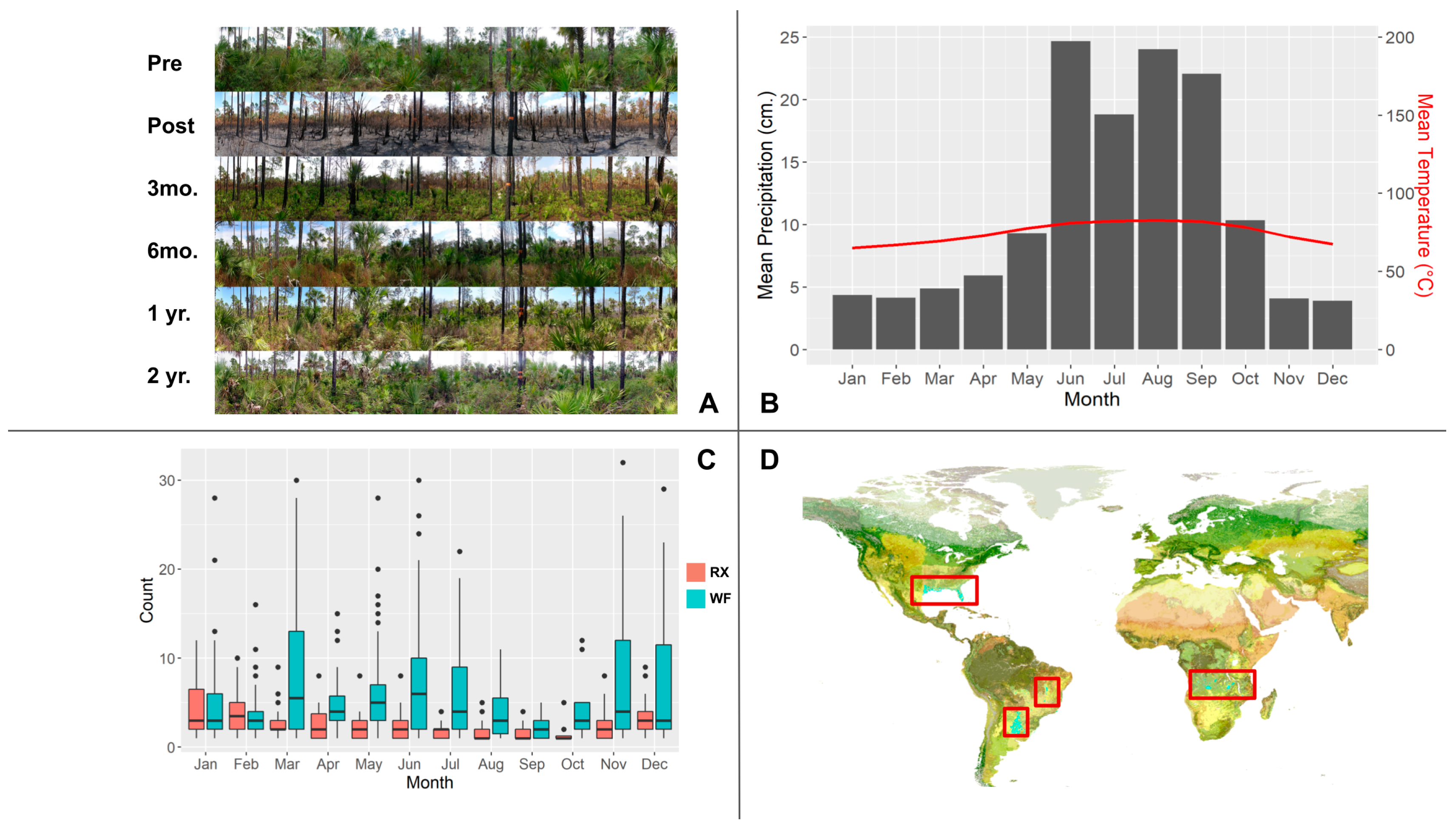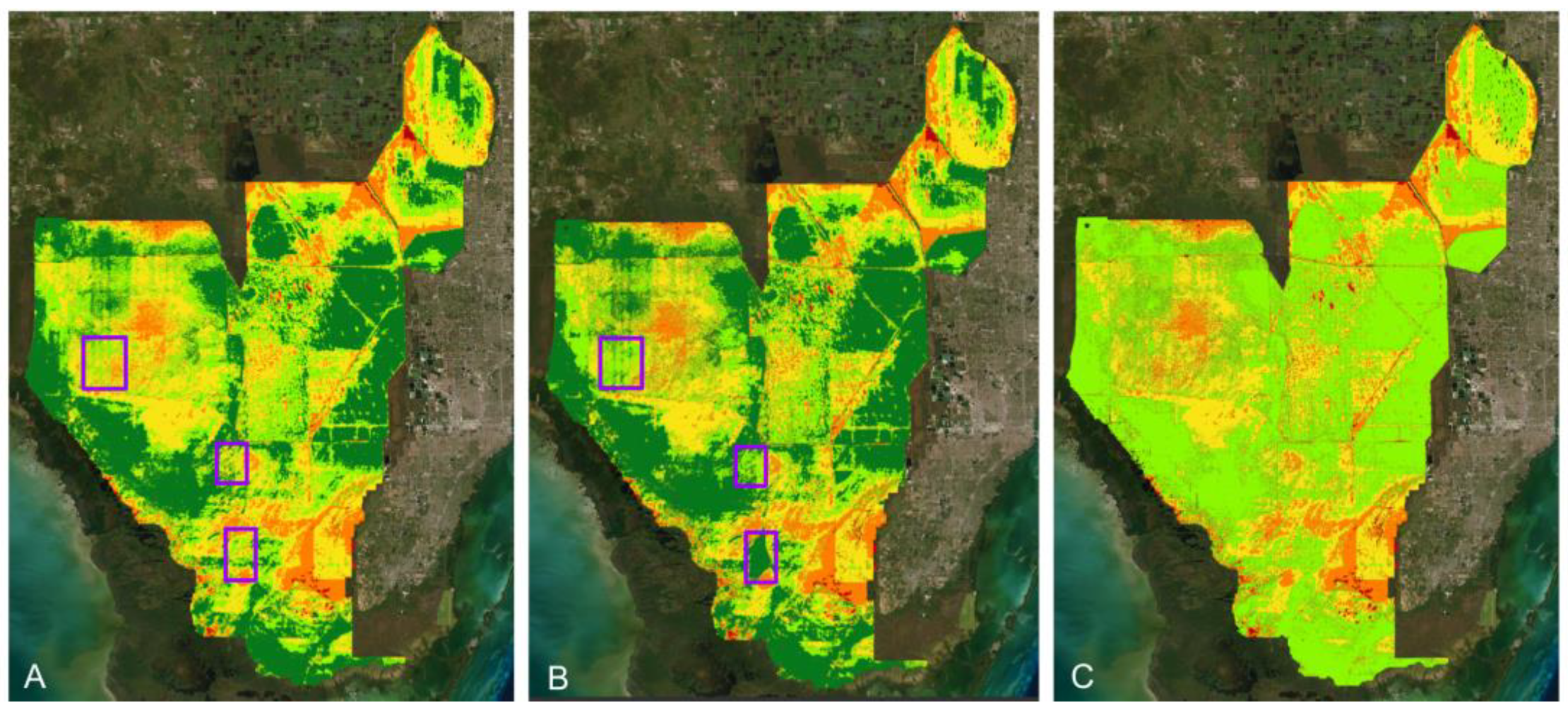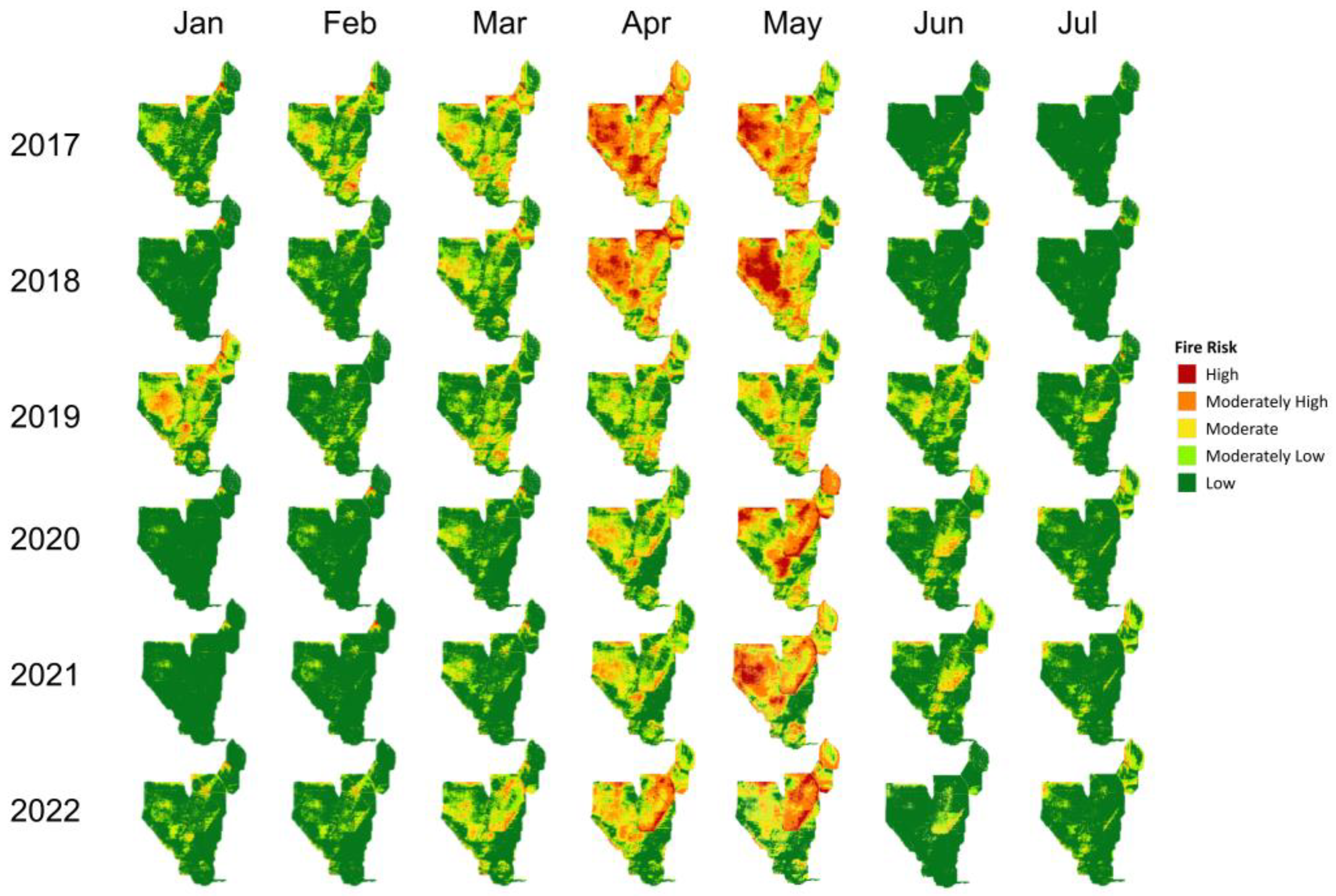Mapping South Florida Daily Fire Risk for Decision Support Using Fuel Type, Water Levels, and Burn History
Abstract
:1. Introduction
2. Model Inputs and Parameters
2.1. Model Overview and Data Descriptions
2.1.1. DEM
2.1.2. Water Levels
2.1.3. Vegetation Fuel Types
2.1.4. Management Units
2.1.5. Energy Release Component
2.1.6. Energy Release Component
3. Model Results and Performance
3.1. Model Outputs
3.1.1. Water Level Risk
3.1.2. ERC-Modified Risk
3.1.3. Historical Burn Modified Risk
3.2. Model Evaluation
3.2.1. Water Level Risk Classes
3.2.2. Iterating with Fire Managers and Sample Risk Class Modifications
3.2.3. ERC and Historical Burn Footprints
4. Discussion
5. Conclusions
Author Contributions
Funding
Data Availability Statement
Acknowledgments
Conflicts of Interest
Appendix A
| Final Fire Risk Class | Water Level Risk Class | ERC Risk Class |
|---|---|---|
| High | 1 | 1, 2 |
| Moderately High | 1 | 3 |
| Moderately High | 2 | 1, 2, 3 |
| Moderate | 1, 2 | 4, 5 |
| Moderate | 3 | 1, 2, 3 |
| Moderate | 4 | 1, 2 |
| Moderately Low | 4 | 3 |
| Moderately Low | 3 | 4, 5 |
| Moderately Low | 5 | 1, 2, 3 |
| Low | 4, 5 | 4, 5 |
References
- Senande-Rivera, M.; Insua-Costa, D.; Miguez-Macho, G. Spatial and Temporal Expansion of Global Wildland Fire Activity in Response to Climate Change. Nat. Commun. 2022, 13, 1208. [Google Scholar] [CrossRef] [PubMed]
- Rogers, B.M.; Balch, J.K.; Goetz, S.J.; Lehmann, C.E.R.; Turetsky, M. Focus on Changing Fire Regimes: Interactions with Climate, Ecosystems, and Society. Environ. Res. Lett. 2020, 15, 030201. [Google Scholar] [CrossRef]
- Halofsky, J.E.; Peterson, D.L.; Harvey, B.J. Changing Wildfire, Changing Forests: The Effects of Climate Change on Fire Regimes and Vegetation in the Pacific Northwest, USA. Fire Ecol. 2020, 16, 4. [Google Scholar] [CrossRef] [Green Version]
- Keeley, J.E.; Syphard, A.D. Large California Wildfires: 2020 Fires in Historical Context. Fire Ecol. 2021, 17, 22. [Google Scholar] [CrossRef]
- McColl-Gausden, S.; Bennett, L.; Clarke, H.; Ababei, D.; Penman, T. The Fuel–Climate–Fire Conundrum: How Will Fire Regimes Change in Temperate Eucalypt Forests under Climate Change? Glob. Chang. Biol. 2022, 28, 5211–5226. [Google Scholar] [CrossRef]
- Boisramé, G.F.S.; Brown, T.J.; Bachelet, D.M. Trends in Western USA Fire Fuels Using Historical Data and Modeling. Fire Ecol. 2022, 18, 8. [Google Scholar] [CrossRef]
- Jolly, W.M.; Cochrane, M.A.; Freeborn, P.H.; Holden, Z.A.; Brown, T.J.; Williamson, G.J.; Bowman, D.M.J.S. Climate-Induced Variations in Global Wildfire Danger from 1979 to 2013. Nat. Commun. 2015, 6, 7537. [Google Scholar] [CrossRef] [Green Version]
- Jones, M.W.; Abatzoglou, J.T.; Veraverbeke, S.; Andela, N.; Lasslop, G.; Forkel, M.; Smith, A.J.P.; Burton, C.; Betts, R.A.; van der Werf, G.R.; et al. Global and Regional Trends and Drivers of Fire Under Climate Change. Rev. Geophys. 2022, 60, e2020RG000726. [Google Scholar] [CrossRef]
- Worsnop, R.P.; Scheuerer, M.; Di Giuseppe, F.; Barnard, C.; Hamill, T.M.; Vitolo, C. Probabilistic Fire-Danger Forecasting: A Framework for Week-Two Forecasts Using Statistical Post-Processing Techniques and the Global ECMWF Fire Forecast System (GEFF). Weather Forecast. 2021, 36, 2113–2125. [Google Scholar] [CrossRef]
- Fernandes, K.; Bell, M.; Muñoz, Á.G. Combining Precipitation Forecasts and Vegetation Health to Predict Fire Risk at Subseasonal Timescale in the Amazon. Environ. Res. Lett. 2022, 17, 074009. [Google Scholar] [CrossRef]
- Hood, S.M.; Varner, J.M.; Jain, T.B.; Kane, J.M. A Framework for Quantifying Forest Wildfire Hazard and Fuel Treatment Effectiveness from Stands to Landscapes. Fire Ecol. 2022, 18, 33. [Google Scholar] [CrossRef]
- Parisien, M.-A.; Miller, C.; Parks, S.A.; DeLancey, E.R.; Robinne, F.-N.; Flannigan, M.D. The Spatially Varying Influence of Humans on Fire Probability in North America. Environ. Res. Lett. 2016, 11, 075005. [Google Scholar] [CrossRef]
- Oliveira, S.; Rocha, J.; Sá, A. Wildfire Risk Modeling. Curr. Opin. Environ. Sci. Health 2021, 23, 100274. [Google Scholar] [CrossRef]
- Iglesias, V.; Balch, J.K.; Travis, W.R. U.S. Fires Became Larger, More Frequent, and More Widespread in the 2000s. Sci. Adv. 2022, 8, eabc0020. [Google Scholar] [CrossRef] [PubMed]
- Cohen, J.D.; Deeming, J.E. The National Fire-Danger Rating System: Basic Equations; U.S. Department of Agriculture, Forest Service, Pacific Southwest Forest and Range Experiment Station: Berkeley, CA, USA, 1985; pp. 1–23.
- Zacharakis, I.; Tsihrintzis, V.A. Environmental Forest Fire Danger Rating Systems and Indices around the Globe: A Review. Land 2023, 12, 194. [Google Scholar] [CrossRef]
- Walding, N.G.; Williams, H.T.P.; McGarvie, S.; Belcher, C.M. A Comparison of the US National Fire Danger Rating System (NFDRS) with Recorded Fire Occurrence and Final Fire Size. Int. J. Wildland Fire 2018, 27, 99. [Google Scholar] [CrossRef]
- Hunter, M.E.; Colavito, M.M.; Wright, V. The Use of Science in Wildland Fire Management: A Review of Barriers and Facilitators. Curr. For. Rep. 2020, 6, 354–367. [Google Scholar] [CrossRef]
- Ruiz, P.L.; Sah, J.P.; Ross, M.S.; Spitzig, A.A. Tree Island Response to Fire and Flooding in the Short-Hydroperiod Marl Prairie Grasslands of the Florida Everglades, USA. Fire Ecol. 2013, 9, 38–54. [Google Scholar] [CrossRef]
- Platt, R.V. A Model of Exurban Land-Use Change and Wildfire Mitigation. Environ. Plan. B Plan. Des. 2006, 33, 749–765. [Google Scholar] [CrossRef]
- Everglades National Park Headquarters National Park Service Begins Prescribed Fire Operations across South Florida. Available online: https://www.nps.gov/ever/learn/news/2021soflrxfirepr.htm (accessed on 15 March 2023).
- U.S. Census Bureau. American Community Survey 1-Year Estimates. Available online: http://censusreporter.org/profiles/31000US33100-miami-fort-lauderdale-pompano-beach-fl-metro-area/ (accessed on 1 June 2023).
- Rifat, S.A.A.; Liu, W. Quantifying Spatiotemporal Patterns and Major Explanatory Factors of Urban Expansion in Miami Metropolitan Area During 1992–2016. Remote Sens. 2019, 11, 2493. [Google Scholar] [CrossRef] [Green Version]
- Volk, M.; Hoctor, T.; Nettles, B.; Hilsenbeck, R.; Putz, F. Florida Land Use and Land Cover Change in the Past 100 Years. In Florida’s Climate: Changes, Variations, & Impacts; Digital Repository; Florida Climate Institute, Florida State University: Tallahassee, FL, USA, 2017; ISBN 978-1-979091-04-6. [Google Scholar]
- Stainback, G.A.; Lai, J.H.; Pienaar, E.F.; Adam, D.C.; Wiederholt, R.; Vorseth, C. Public Preferences for Ecological Indicators Used in Everglades Restoration. PLoS ONE 2020, 15, e0234051. [Google Scholar] [CrossRef] [PubMed]
- Inglis, N.C.; Vukomanovic, J. Visualizing When, Where, and How Fires Happen in U.S. Parks and Protected Areas. IJGI 2020, 9, 333. [Google Scholar] [CrossRef]
- Stevenson, J. Evolution of Fire Management in Florida’s State Parks. In Fire in Ecosystem Management: Shifting the Paradigm from Suppression to Prescription; Tall Timbers Research Station: Tallahassee, FL, USA, 1998; Volume 20, pp. 99–101. [Google Scholar]
- Houseknect, J.; Big Cypress National Preserve, Copeland, FL, USA. Personal communication, 2023.
- O’Leary, M.; Pernas, T.; Sullivan, J. Big Cypress National Preserve Fire Management Plan; National Park Service: Big Cypress Preserve Florida, FL, USA, 2020; pp. 1–112.
- U.S. Fish and Wildlife Service Southeast Region. Prescribed Fire Transition Panoramic; Flicker: San Francisco, CA, USA, 2008.
- Florida Climate Center. Available online: https://climatecenter.fsu.edu/climate-data-access-tools (accessed on 15 March 2023).
- Sayre, R.; Karagulle, D.; Frye, C.; Boucher, T.; Wolff, N.; Breyer, S.; Wright, D.; Martin, M.; Butler, K.; Van Graafeiland, K.; et al. An assessment of the representation of ecosystems in global protected areas using new maps of World Climate Regions and World Ecosystems. Glob. Ecol. Conserv. 2020, 21, e00860. [Google Scholar] [CrossRef]
- Cioffi, F.; Conticello, F.R.; Lall, U. Stochastic Scenarios for 21st Century Rainfall Seasonality, Daily Frequency, and Intensity in South Florida. J. Water Resour. Plann. Manag. 2020, 146, 04020058. [Google Scholar] [CrossRef]
- Snyder, J.; Ross, M.; Koptur, S.; Sah, J. Developing Ecological Criteria for Prescribed Fire in South Florida Pine Rockland Ecosystems; Bureau of Land Management: Southeast Environmental Research Center, Florida International University Digital Commons; U.S. Geological Survey: Miami, FL, USA, 1997; pp. 1–114.
- Fowler, C.; Konopik, E. The History of Fire in the Southern United States. Hum. Ecol. Rev. 2007, 14, 12. [Google Scholar]
- Wear, D.N.; Greis, J.G. The Southern Forest Futures Project: Technical Report; USDA-Forest Service, Southern Research Station: Asheville, NC, USA, 2013; pp. 1–542.
- Pearlstine, L.G.; Pearlstine, E.V.; Aumen, N.G. A Review of the Ecological Consequences and Management Implications of Climate Change for the Everglades. J. N. Am. Benthol. Soc. 2010, 29, 1510–1526. [Google Scholar] [CrossRef] [Green Version]
- D’Acunto, L.E.; Pearlstine, L.; Haider, S.M.; Hackett, C.E.; Shinde, D.; Romañach, S.S. The Everglades Vulnerability Analysis: Linking Ecological Models to Support Ecosystem Restoration. Front. Ecol. Evol. 2023, 11, 1111551. [Google Scholar] [CrossRef]
- Harvey, J.W.; Wetzel, P.R.; Lodge, T.E.; Engel, V.C.; Ross, M.S. Role of a Naturally Varying Flow Regime in Everglades Restoration: High-Flow Restoration of Wetland Ecology. Restor. Ecol. 2017, 25, S27–S38. [Google Scholar] [CrossRef]
- Graf, W.L. Water Resources Science, Policy, and Politics for the Florida Everglades. Ann. Assoc. Am. Geogr. 2013, 103, 353–362. [Google Scholar] [CrossRef]
- Romañach, S.S.; Haider, S.M.; Hackett, C.; McKelvy, M.; Pearlstine, L.G. Managing Multiple Species with Conflicting Needs in the Greater Everglades. Ecol. Indic. 2022, 136, 108669. [Google Scholar] [CrossRef]
- Papa, F.; Frappart, F. Surface Water Storage in Rivers and Wetlands Derived from Satellite Observations: A Review of Current Advances and Future Opportunities for Hydrological Sciences. Remote Sens. 2021, 13, 4162. [Google Scholar] [CrossRef]
- U.S. Geological Survey. USGS Original Product Resolution FL_Peninsular 2022. Available online: https://rockyweb.usgs.gov/vdelivery/Datasets/Staged/Elevation/OPR/Projects/ (accessed on 16 December 2021).
- Haider, S.; Swain, E.; Beerens, J.; Petkewich, M.; McCloskey, B.; Henkel, H. The Everglades Depth Estimation Network (EDEN) Surface-Water Interpolation Model, Version 3; USGS Greater Everglades Priority Ecosystems Science Program; U.S. Department of the Interior: Washington, DC, USA, 2020; pp. 1–44.
- Finney, M.A.; McHugh, C.W.; Grenfell, I.; Riley, K.L. Continental-Scale Simulation of Burn Probabilities, Flame Lengths, and Fire Size Distribution for the United States. In Proceedings of the VI International Conference on Forest Fire Research, Coimbra, Portugal, 15–18 November 2010. [Google Scholar]
- Jolly, W.; Freeborn, P.; Page, W.; Butler, B. Severe Fire Danger Index: A Forecastable Metric to Inform Firefighter and Community Wildfire Risk Management. Fire 2019, 2, 47. [Google Scholar] [CrossRef] [Green Version]
- Interagency Standards for Fire and Fire Aviation Operations Group. Chapter 10: Preparedness; National Interagency Fire Center: Boise, ID, USA, 2023; p. 220.
- Ruiz, P.; Schall, T.; Shamblin, R.; Whelan, K. The Vegetation of Everglades Natinoal Park: Final Report; National Park Service: Fort Collins, CO, USA, 2021.
- National Wildfire Coordinating Group Surface Fuel Model Descriptions. Available online: https://www.nwcg.gov/publications/pms437/fuels/surface-fuel-model-descriptions (accessed on 31 March 2023).
- Scott, J.H.; Burgan, R.E. Standard Fire Behavior Fuel Models: A Comprehensive Set for Use with Rothermel’s Surface Fire Spread Model; U.S. Department of Agriculture, Forest Service, Rocky Mountain Research Station: Ft. Collins, CO, USA, 2005; pp. 17–66.
- Florida Natural Areas Inventory. Cooperative Land Cover, Version 3.6. 2022. Available online: https://www.fnai.org/services/coop-land-cover (accessed on 11 December 2022).
- Hall, B.; Brown, T.; Bradshaw, L.; Jolly, W.; Nemani, R. National Standardized Energy Release Component Forecasts. In Proceedings of the 5th Symposium on Fire and Forest Meteorology, Boston, MA, USA, 16 November 2003; American Meteorological Society: Boston, MA, USA; Orlando, FL, USA, 2003; p. 172. [Google Scholar]
- National Wildland Fire Coordinating Group. NWCG Standards for Prescribed Fire Planning and Implementation. Fire Use Subcommittee; 2022; pp. 1–51. Available online: https://www.nwcg.gov/sites/default/files/publications/pms484.pdf (accessed on 9 May 2023).
- Reimer, J.; Thompson, D.K.; Povak, N. Measuring Initial Attack Suppression Effectiveness through Burn Probability. Fire 2019, 2, 60. [Google Scholar] [CrossRef] [Green Version]
- Menges, E.S.; Marks, P.L. Fire and Flood: Why Are South-Central Florida Seasonal Ponds Treeless? Am. Midl. Nat. 2008, 159, 8. [Google Scholar] [CrossRef]
- van Wagtendonk, J.W. The History and Evolution of Wildland Fire Use. Fire Ecol. 2007, 3, 3–17. [Google Scholar] [CrossRef]
- Medeiros, S.; Hagen, S.; Weishampel, J.; Angelo, J. Adjusting Lidar-Derived Digital Terrain Models in Coastal Marshes Based on Estimated Aboveground Biomass Density. Remote Sens. 2015, 7, 3507–3525. [Google Scholar] [CrossRef] [Green Version]
- Cruz, M.G.; Alexander, M.E.; Kilinc, M. Wildfire Rates of Spread in Grasslands under Critical Burning Conditions. Fire 2022, 5, 55. [Google Scholar] [CrossRef]
- Pearlstine, L.G.; Beerens, J.M.; Reynolds, G.; Haider, S.M.; McKelvy, M.; Suir, K.; Romañach, S.S.; Nestler, J.H. Near-Term Spatial Hydrologic Forecasting in Everglades, USA for Landscape Planning and Ecological Forecasting. Environ. Model. Softw. 2020, 132, 104783. [Google Scholar] [CrossRef]
- Gamboa, G.; Otero, I.; Bueno, C.; Arilla, E.; Ballart, H.; Camprubí, L.; Canaleta, G.; Tolosa, G.; Castellnou, M. Participatory Multi-Criteria Evaluation of Landscape Values to Inform Wildfire Management. J. Environ. Manag. 2023, 327, 116762. [Google Scholar] [CrossRef]
- Thompson, M.P.; Gannon, B.M.; Caggiano, M.D.; O’Connor, C.D.; Brough, A.; Gilbertson-Day, J.W.; Scott, J.H. Prototyping a Geospatial Atlas for Wildfire Planning and Management. Forests 2020, 11, 909. [Google Scholar] [CrossRef]







Disclaimer/Publisher’s Note: The statements, opinions and data contained in all publications are solely those of the individual author(s) and contributor(s) and not of MDPI and/or the editor(s). MDPI and/or the editor(s) disclaim responsibility for any injury to people or property resulting from any ideas, methods, instructions or products referred to in the content. |
© 2023 by the authors. Licensee MDPI, Basel, Switzerland. This article is an open access article distributed under the terms and conditions of the Creative Commons Attribution (CC BY) license (https://creativecommons.org/licenses/by/4.0/).
Share and Cite
Jones, K.; Vukomanovic, J. Mapping South Florida Daily Fire Risk for Decision Support Using Fuel Type, Water Levels, and Burn History. Fire 2023, 6, 236. https://doi.org/10.3390/fire6060236
Jones K, Vukomanovic J. Mapping South Florida Daily Fire Risk for Decision Support Using Fuel Type, Water Levels, and Burn History. Fire. 2023; 6(6):236. https://doi.org/10.3390/fire6060236
Chicago/Turabian StyleJones, Kate, and Jelena Vukomanovic. 2023. "Mapping South Florida Daily Fire Risk for Decision Support Using Fuel Type, Water Levels, and Burn History" Fire 6, no. 6: 236. https://doi.org/10.3390/fire6060236






